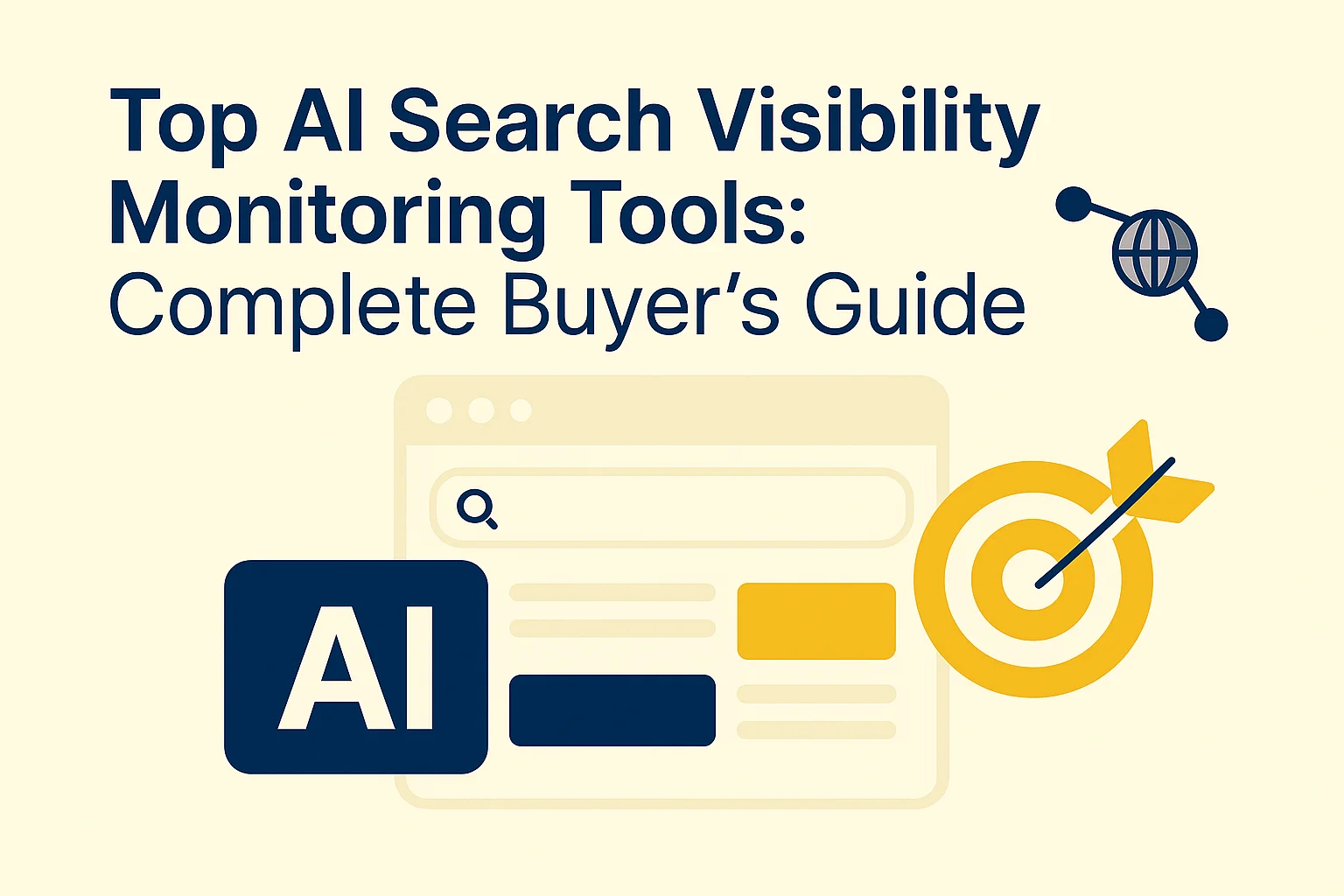


Our definitive, data‑driven ranking (and selection playbook) for AEO/GEO platforms
And yes, AI shopping is now real distribution: ChatGPT “Instant Checkout” is live (Etsy now, Shopify next), Perplexity Shopping supports one‑click checkout, and Amazon Rufus keeps expanding. If your products live in any of those ecosystems, you need a tool that sees—and improves—your shelf space on those surfaces.
Why this guide (and how it’s different)
Generative engines (ChatGPT, Gemini, Claude, Perplexity, Copilot, Grok, etc.) now answer first and link second. Google’s AI Mode and AI Overviews cemented that behavior for billions of searches; meanwhile, conversational shopping is moving from experiment to default in multiple assistants. That flips the classic SEO funnel. Your content isn’t just “ranking”—it’s being summarized, compared, labeled, and sometimes sold without a click.
This guide is built for operators lSEO leads, growth engineers, and CMOs who need a pragmatic map of the AEO/GEO market. I used vendor product docs, pricing pages, and primary announcements as of Oct 1, 2025. Where pricing or feature detail wasn’t publicly listed, we say so plainly.
Conflict‑of‑interest note: I’m affiliated with Goodie AI. To keep this useful, I publish my scoring rubric (below), cite primary sources for every vendor, and call out weaknesses, even for us.
The scoring model we used
We created an AI Search Visibility Optimization Score (ASVO) out of 100, weighted for what actually moves the needle in 2025:
Method: We derived scores from public feature pages, pricing, docs, and enterprise claims. Where vendors publish hard compliance claims (e.g., SOC 2), we award full credit. Where detail is missing, we score conservatively.
Reality check on the landscape: Google’s AI Mode/AI Overviews keep evolving; ChatGPT and Perplexity are now real commerce surfaces; Amazon Rufus is mainstream. Your stack must see—and act on—those surfaces, not just track “mentions.”
Prices below reflect what vendors publish publicly as of Q4 2025. If a site lists “Contact sales,” we note it.
What it is: A closed‑loop Answer Engine Optimization platform—monitor → optimize (agentic) → attribute impact—across major LLMs and AI surfaces (ChatGPT, Gemini, Claude, Perplexity, DeepSeek, Google AI Overviews & AI Mode, Grok, Amazon Rufus, Meta AI, Copilot).
Why it leads:
Pricing: Not publicly listed (enterprise; “Get a demo”).
Ideal for: Mid‑market to enterprise teams that want one system to measure → fix → prove ROI (SEO + Content + PR + Growth Engineering).
Pros: End‑to‑end; broadest surface coverage (including AI Mode and Rufus); strong technical AEO; clear optimization workflows; analytics that matter.
Cons: No self‑serve pricing; teams still learning AEO may need enablement (Goodie provides guides and frameworks, but it’s a new muscle).
What it is: An AI visibility platform with Answer Engine Insights, Agent Analytics, Prompt Volumes, and Shopping modules; covers ChatGPT, Perplexity, Grok, Copilot, Meta AI, DeepSeek, and Google AI Overviews. SOC 2 Type II and SSO.
Pricing: Enterprise only (custom).
Ideal for: Large brands and agencies that value compliance, SSO, and a modular approach (visibility + content workflows + shopping).
Pros: Enterprise posture (SOC 2, SSO); clear dashboards; “Prompt Volumes” data; early ChatGPT Shopping orientation.
Cons: No public pricing; content/action workflows are improving but less opinionated than a fully agentic stack.
What it is: An “AI search optimization” platform with deep technical SEO (crawl, log analysis, bot behavior) plus guidance for AI Overviews and expanding agent workflows.
Pricing: Enterprise (contact sales).
Ideal for: Enterprise sites with millions of URLs where site health, crawlability, and AI bot behavior must be rock‑solid before you chase citations.
Pros: Unmatched log‑file/technical depth; AI Overviews content guidance; evolving AI agent features and automation.
Cons: Less emphasis (today) on cross‑LLM visibility and shopping placements compared to Goodie/Profound.
What it is: A straightforward AI visibility tracker with competitor benchmarking, prompt tracking, and clean reporting. Transparent pricing with a free trial.
Pricing (monthly): Starter €89, Pro €199, Enterprise €499+ (add Gemini/AI Mode/Claude/DeepSeek for a fee).
Ideal for: SMBs and agencies needing quick coverage and reports without enterprise complexity.
Pros: Price transparency; daily runs; easy to explain; multi‑country options at higher tiers.
Cons: Action/agent layers and technical bot analytics are lighter than enterprise platforms.
What it is: An enterprise “AI marketing” platform focused on visibility, favorability, and message consistency across AI assistants—funded and building for Fortune 500 scale.
Pricing: Not publicly listed (sales‑led).
Ideal for: Enterprise brand, comms, and category teams prioritizing narrative control at scale across assistants.
Pros: Enterprise focus; investor‑backed buildout; messaging/brand‑safety orientation.
Cons: Less transparent pricing; fewer public product specifics than visibility‑first tools.
What it is: Monitoring + insights, plus AXP, which generates an AI‑friendly version of your site for LLM consumption. Clear, public pricing.
Pricing (monthly): $300 (Starter), $500 (Growth), $1,000 (Pro), Enterprise custom; includes seats, prompt limits, personas, and audits.
Ideal for: Teams that want to shape what AI reads (AXP) while tracking presence/citations.
Pros: AXP concept is practical; good enterprise notes (SOC2, RBAC, Data API).
Cons: AXP requires governance; mid‑market focus—less depth in shopping and agent analytics than leader tools.
What it is: Brand monitoring + content strategy with AI Brand Index and “AI Brand Score,” Custom Prompts, and prompt‑volume research.
Pricing: Book demo (no public list).
Ideal for: Consumer categories where share‑of‑voice and attribute perception (e.g., “best for comfort”) matters in AI answers.
Pros: Consumer preference mapping; brand wording/sentiment breakdowns; multi‑LLM coverage.
Cons: Fewer public details on enterprise workflow/attribution; shopping placements not a primary theme on public pages.
What it is: An AEO platform with free one‑time audit and enterprise program; includes research/playbooks, multi‑platform tracking, and managed‑services options.
Pricing: Free one‑time audit; Enterprise custom.
Ideal for: Teams that want tooling plus an execution partner.
Pros: Price‑friendly entry; credible logos; playbook‑driven optimization.
Cons: Opaque ongoing platform pricing; service dependency may not fit in‑house teams.
What it is: Focused AI Overviews + ChatGPT + Perplexity tracker; claims multi‑country AI Overviews monitoring and publishes AIO research.
Pricing: Not clearly listed on homepage; appears product‑led with trials via third‑party reviews.
Ideal for: SEO teams who specifically need Google AI Overviews screenshots/text tracking at scale.
Pros: Country coverage and AIO‑specific features.
Cons: Narrower scope; fewer action/attribution features.
What it is: Brand/competitor coverage across “all AI models,” with simple insights and onboarding.
Pricing: Public site shows trial flow; specific pricing varies in directories; treat as lightweight.
Ideal for: Early‑stage teams who want AI presence snapshots without deeper ops.
Pros: Simple prompts‑to‑visibility workflow.
Cons: Less mature action layer, limited enterprise detail.
What it is: A developer‑friendly content optimizer that creates schema.org, AI‑friendly summaries, and metadata to improve citability and machine readability—more “optimizer” than “monitor.”
Pricing: Early/Founder program; not a classic SaaS tracker.
Ideal for: Content and web teams who need to retrofit pages for AI retrieval and summarization.
Pros: Practical, tactical outputs; Next.js plugin; clarifies what LLMs prefer structurally.
Cons: No LLM observability or attribution; complements (not replaces) a visibility platform.
What it is: Brand/product assessments, LLM monitoring, and “affinity optimization” planning. Limited public detail.
Pricing: Book demo.
Ideal for: Brand teams exploring “AI affinity” in categories.
Pros: Framing around brand attributes and sentiment.
Cons: Less transparent product coverage/pricing.
Bottom line: If your AEO tool can’t see these surfaces, it can’t guide your revenue strategy.
SEO helps people find you; AEO makes your brand the answer. It’s about being present, accurate, and cited inside AI‑generated responses—not just ranking in blue links.
Yes. AI Overviews and AI Mode are distinct user experiences with different triggers and layouts. Vendors track them explicitly (and many now publish AIO studies).
No. OpenAI, Perplexity, and Amazon have all shipped real commerce features. This is distribution, not a beta. If you sell products, treat AI shopping as a core channel.
No. Your best odds come from (1) being observable across surfaces, (2) fixing the right content/technical issues quickly, (3) earning citations from sources those models trust, and (4) measuring outcomes so you can iterate. Tools help the process; none control the model.
Education (5): Vendor‑published research/guides that help teams adopt AEO/GEO (e.g., Botify’s AIO playbooks; Goodie’s AEO explainers).
We didn’t fabricate closed‑door benchmarks. This ranking is capability‑based, grounded in public product claims and docs as of Oct 1, 2025, plus our operator judgment about what actually shifts AI visibility in practice. When a vendor didn’t publish enough detail (e.g., precise pricing), we scored conservatively and called it out.
If you need one platform to monitor, act, and prove especially across the new AI shopping surfaces. Goodie is our top pick in 2025. Pair it with a rigorous program (citations + technical health + attribution), and you’ll build an advantage that outlasts algorithm noise.